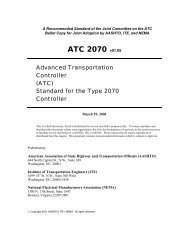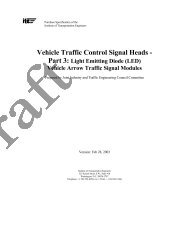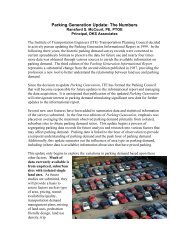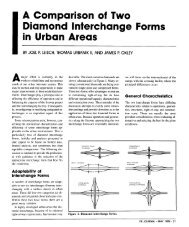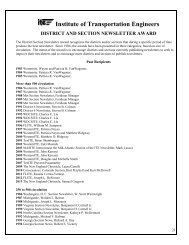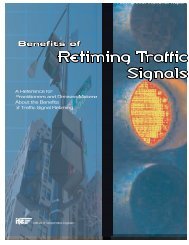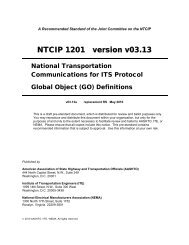A Speed Reduction Strategy in Local Street Systems - Institute of ...
A Speed Reduction Strategy in Local Street Systems - Institute of ...
A Speed Reduction Strategy in Local Street Systems - Institute of ...
Create successful ePaper yourself
Turn your PDF publications into a flip-book with our unique Google optimized e-Paper software.
Humps - A <strong>Speed</strong> <strong>Reduction</strong> <strong>Strategy</strong> <strong>in</strong> <strong>Local</strong> <strong>Street</strong> <strong>Systems</strong><br />
Sue DattaaandTapanK. Datta,Ph.D., P.E.’<br />
Residential area speed control has been a critical issue for local<br />
Trat%c Eng<strong>in</strong>eers for several decades. Eng<strong>in</strong>eers have<br />
attempted to utilire acceptable freatrnents such as road clsum,<br />
diverters, speed humps and roundabouts, to some<br />
unacceptable treatments such as midblock and unwarranted<br />
stop signs. These efforts have met with vary<strong>in</strong>g levels <strong>of</strong><br />
success <strong>in</strong> the past.<br />
Itis also importanto note that the speed<strong>in</strong>g on local street<br />
systems and cut-through tile <strong>in</strong> our neighborhoods are the<br />
two most important concerns <strong>in</strong> many suburban CQmmunides<br />
m the USA. Traftlc Eng<strong>in</strong>eers <strong>of</strong>teu spend countless hours<br />
either study<strong>in</strong>g and/or answer<strong>in</strong>g citizens’ compla<strong>in</strong>ts aud<br />
concerns on such issues. Traffic <strong>of</strong>fkials <strong>in</strong> a local comrmmity<br />
have very few options <strong>in</strong> terms <strong>of</strong> implement<strong>in</strong>g countermeasures+for<br />
such a traflic problem <strong>in</strong> our neighborhoods.<br />
The elected <strong>of</strong>ficials <strong>in</strong> many suburban cmunuuities <strong>of</strong>ten<br />
satisfy pUbliC demand to mitigate speed<strong>in</strong>g and cuMhrough<br />
trafllc problems by approv<strong>in</strong>g unwarranted stop signs and fourway<br />
stop signs. Past studies have <strong>in</strong>dicated that such measures<br />
do not work unless there is some sort <strong>of</strong> sight restriction at<br />
local street <strong>in</strong>tersections. Eng<strong>in</strong>eers recently raised issues with<br />
our current stop sign guidel<strong>in</strong>es and theii effectiveness.<br />
Studies are required to prove or disprove the effectiveness <strong>of</strong><br />
exist<strong>in</strong>g tw~way stop signs and four-way stop signs, warrants<br />
and guideJi.nes, as per the Manual <strong>of</strong> Uniform Traffic Control<br />
Devices ~). N tilC Officid$ are under Constant<br />
pressure fforn the elected <strong>of</strong>ficials’ popular and <strong>in</strong>didmimmt<br />
use <strong>of</strong> stop Signs.<br />
<strong>Local</strong> area speed control and @-through traftIc are <strong>of</strong>ten<br />
related issues and require careful study. If a residential area<br />
road provides an alternative to congested arterial streets, there<br />
will be both speed<strong>in</strong>g and cut-through trat%c <strong>in</strong> our neighborhood<br />
<strong>Street</strong> SySteIU. MSny cOUntlieS<strong>in</strong> tiOpe SUd SkO iU<br />
Australia traffic <strong>of</strong>ficials have aggressively pursued various<br />
physical freatrnents <strong>in</strong> their local street systems. They <strong>in</strong>clude:<br />
* Roundabouts,<br />
● <strong>Speed</strong> humps,<br />
●<br />
●<br />
●<br />
●<br />
●<br />
Road ChSUK!S,<br />
Dips,<br />
Diverters,<br />
chokers,<br />
and other physical mitigation measures.<br />
These treatments are referred to as traflic calm<strong>in</strong>g devices.<br />
Various cities <strong>in</strong> the USA have been experiment<strong>in</strong>g with many<br />
<strong>of</strong> these measures to slow down and reduce traffic <strong>in</strong> our<br />
residential areas.<br />
Residential collector roads, which are <strong>of</strong>ten long, particularly<br />
<strong>in</strong> older subdivisions with grid type or near grid type road<br />
layouts, can provide an alternative means <strong>of</strong> through travel. If<br />
we measure the speeds, we fd the 85th percentile to range<br />
ffom 30 to 45 mph. However, does this mean we ought to<br />
change speed limits to higher ones utiliz<strong>in</strong>g the 85th percentile<br />
speed? Probably not consider<strong>in</strong>g the nature and dom<strong>in</strong>ant<br />
fimction <strong>of</strong> the collector and local roads. A reasonable and<br />
<strong>in</strong>telligent option would be to keep such areas at 25 mph,<br />
while develop<strong>in</strong>g and <strong>in</strong>stall<strong>in</strong>g physical measures which Wti<br />
face motorists to slow down. This br<strong>in</strong>gs up another issue<br />
which is as controvemial as residential area traffic control.<br />
This is the issue <strong>of</strong> sett<strong>in</strong>g speed limits based on 85th percentile<br />
speedonly. Somestatesutilize geometic and functional<br />
factow <strong>in</strong> additionto, the85th pementilespeedasthedeterm<strong>in</strong>ant<br />
<strong>of</strong> speed limits. Gthers have only followed the 85th<br />
percentile speed for sett<strong>in</strong>g speed lids.<br />
The objective <strong>of</strong> tids study was to evaiuate if the <strong>in</strong>stallation<br />
<strong>of</strong> a physical measure such as a speed hump signitkantly<br />
reduces operat<strong>in</strong>g speeds and tile volumes.<br />
A speed hump is a raised area <strong>in</strong> the roadway surface extend<strong>in</strong>g<br />
the entire travelway with the crest height behveen three to<br />
four <strong>in</strong>ches, and a length <strong>of</strong> approximately twelve feet, The<br />
higher the crest height and shortti the length <strong>of</strong> the hump, the<br />
worse is the driver and passenger discomfort. The underly<strong>in</strong>g<br />
‘ Transportation Planner, Goodell-Grivas, Inc.<br />
b Pr<strong>of</strong>essor, Department <strong>of</strong> CiviI and Environmental<br />
Eng<strong>in</strong>eer<strong>in</strong>g, Wayne State University, ITE Member<br />
- Resource Papers for the 1997 InternationalConference 91
pr<strong>in</strong>ciple <strong>of</strong> the hump design is to force motorists to reduce<br />
speed to a level <strong>of</strong> about 15 to 20 mph. ‘lEus, if a vehicle<br />
drives over a speed hump at the speed limit <strong>of</strong> 25 mph for a<br />
residential area, the driver will feel discomfort, yet will not<br />
lose control <strong>of</strong> the vehicle.<br />
Some speed humps may have a parabolic shape or sometimes<br />
have a flat surface on top. The later type <strong>of</strong> humps are<br />
COIWOdY used <strong>in</strong> Austmlia and OCG&OIEd& <strong>in</strong> the USA.<br />
EXPERIENCE<br />
OF SPEED HUMPS<br />
lleuse<strong>of</strong>speed hurnpsas a~ccahn<strong>in</strong>gdevice <strong>in</strong>consistently<br />
ga<strong>in</strong><strong>in</strong>g popularity <strong>in</strong> the USA. Although, Europe and<br />
Australia cont<strong>in</strong>ue to lead the way <strong>in</strong> experiment<strong>in</strong>g with and<br />
<strong>in</strong>stall<strong>in</strong>g speed humps as a traffic calm<strong>in</strong>g device.<br />
The tests conducted <strong>in</strong> England <strong>in</strong>volved various sizes <strong>of</strong> speed<br />
humps. After much study, they decided to use 12-feet wide<br />
and 4-<strong>in</strong>ch high humps. They also tested various spac<strong>in</strong>gs that<br />
ranged from 160 feet to 510 feet between the humps.<br />
Several cities <strong>in</strong> the North America repmted use <strong>of</strong> humps as<br />
trsfilc cahn<strong>in</strong>g device. The City <strong>of</strong> Thousand Oaks, California,<br />
has tested the use <strong>of</strong> humps extensively. The results <strong>of</strong><br />
their before and atler study is as follows<br />
II Site I 85th Percentile <strong>Speed</strong> II<br />
1. Langtry Drive<br />
2. Clarice Avenue<br />
3. Campbell Drive<br />
4. 130nanza Road<br />
5. AvaIon Road<br />
6. Pyramid Drive<br />
AkhouglL there were other sites where speed humps have been<br />
<strong>in</strong>stalle~ these are the locations where there is both before and<br />
afier data available. The after speed data has been verifti by<br />
the authors, by cdect<strong>in</strong>g sample speed data dur<strong>in</strong>g <strong>of</strong>f-peak<br />
periods us<strong>in</strong>g a radar gun <strong>in</strong> the f~ld.<br />
Table 1 shows the before and after speed and volume data at<br />
the six study sites <strong>in</strong> Las Vegas, Nevada.<br />
Table 1. Before and after speed and volume data.<br />
Before<br />
Site = ‘<br />
ADT 85# ADT 85#<br />
speed<br />
speed<br />
Langtry Dr. 25 238 29 191 23<br />
CIarice Ave. 25 3,047 38.12 3,316 26<br />
Campbell Dr. 25 4521 - 2,233 27<br />
Bonanza Rd. 25 3,006 34 3,150 27<br />
Avalon Ave. 25 3,455 37.50 2,040 21.86<br />
Pyramid Dr. 25 2,753 29.02 - 23.1<br />
A study <strong>in</strong> the prov<strong>in</strong>ce <strong>of</strong> British Columbia, Canat@ reported<br />
benefits accrued from accident reduction <strong>in</strong> tangible terms <strong>in</strong><br />
theuse<strong>of</strong> various traffic calm<strong>in</strong>g devices. Inallcases, the<br />
dollar benefits due to the <strong>in</strong>staktion <strong>of</strong> various traffic cahn<strong>in</strong>g<br />
devices far outweighed the cost <strong>of</strong> <strong>in</strong>stallation just from the<br />
reduction <strong>of</strong> accidents.<br />
Such eqeriences have led the authors<strong>of</strong> this paper to conduct<br />
a study to test the statisticalsignificance<strong>of</strong> speed and traffic<br />
volumereduction<strong>in</strong> the residentialareasdue to the imtallation<br />
<strong>of</strong> speed humps. Severalspeed hump sites were selected <strong>in</strong><br />
the City <strong>of</strong> Las Vegas,Nevadato perform this study.<br />
Thebefore speed data for Campbell Drive and after vohnne<br />
data for Pyramid Drive were not available.<br />
The percent changes <strong>in</strong> speed and trafilc volumes at the six<br />
study sites are as follows<br />
Ii site I Percent <strong>Reduction</strong> m n<br />
II i 85th % <strong>Speed</strong> I Am II<br />
Langay Dr. 1 20.6% I 19.7%<br />
STUDYSITES, SPEED AND VOLUME DATA<br />
Rec%ntly the C@ <strong>of</strong> Las Vegas has been <strong>in</strong>staMg speed<br />
humps <strong>in</strong> their residential areas quite aggressively. The<br />
follow<strong>in</strong>g sites <strong>in</strong> the City <strong>of</strong> Las Vegas were selected as a part<br />
<strong>of</strong> this study<br />
m ,<br />
Avalon Rd. I 41.7% I 40.9% 11<br />
I<br />
20.4% I II<br />
92 Resource Papers for the 1997 International Conference<br />
w“
Figures 1,2 and 3 show the locations <strong>of</strong> the study sites <strong>in</strong> the<br />
context <strong>of</strong> the adjacent roadways.<br />
BARNARD<br />
.(J b-l<br />
SERAFIN<br />
B<br />
n<br />
3<br />
,(=<br />
.<br />
3 VALMOR<br />
><br />
Figure 1.<br />
I<br />
.<br />
TORREY PINES DR.<br />
Figute 3.<br />
I<br />
The 85th percentile speedchangesobserved<strong>in</strong> the six study<br />
sites <strong>in</strong> Las Vegas we compared with observed speed changes<br />
<strong>in</strong> other communities and those reported <strong>in</strong> the past. The mean<br />
pment change <strong>in</strong> the 85th percentile speed <strong>in</strong> the six sites <strong>in</strong><br />
Las Vegas is 27.02 percent. This compares favorably with<br />
other experiences. 30 percent reductions on an average, was<br />
observed <strong>in</strong> tests performed <strong>in</strong> England<br />
A befote and after speed study performed for a speed hump<br />
location <strong>in</strong> Kansas City, Missouri showed a reduction <strong>of</strong> the<br />
85th percentile speed fmm 33 mph to 25 mph, thus a reduction<br />
<strong>of</strong> 24.2 percent was observed. The average <strong>of</strong> the two sites m<br />
the City <strong>of</strong> Thousand Oaks, California, reported an overall<br />
reduction <strong>of</strong> the 85th percentile speed <strong>of</strong>21 percent. l%erefore,<br />
the speed reduction observed m the Las Vegas sites is, as<br />
expected <strong>in</strong> comparison with the other studies performed <strong>in</strong> the<br />
USA and abroad<br />
Figure 2.<br />
The reduction <strong>in</strong> Mlc volumes due to the <strong>in</strong>stallation <strong>of</strong><br />
speed humps can only happen if a roadway is carry<strong>in</strong>g cutthmugh<br />
traffic. Cut-through traffi is defmd as the traftic<br />
whose orig<strong>in</strong> and dest<strong>in</strong>ation are both outside the neighborhood<br />
which is under consideration. A study <strong>of</strong> the Average Daily<br />
~ Resource Papers for the 1997 InternationalConference 93
Traffic (ADT) at the five out <strong>of</strong> six sites <strong>in</strong> Las Vegas<br />
revealed that three out <strong>of</strong> five sites reported approximately a<br />
20 to 50 percent reduction <strong>in</strong> ADT. Two sites recxxded<br />
approximately 5 to 9 percent <strong>in</strong>crease <strong>in</strong> traffic volumes. The<br />
Kansas City site recorded a slight <strong>in</strong>crease <strong>in</strong> tmffic volumes.<br />
A study <strong>of</strong> the test sites <strong>in</strong> Las Vegas <strong>in</strong>dicated that the trafllc<br />
volume change may be due to other factors besides the<br />
<strong>in</strong>stallation <strong>of</strong> speed humps.<br />
HUMP INSTALLATIONS<br />
The use <strong>of</strong> humps <strong>in</strong> the USA, while not as popular as <strong>in</strong><br />
England, is still ga<strong>in</strong><strong>in</strong>g popularity rapidly. In genemi, most<br />
communities <strong>in</strong> the USA seek<strong>in</strong>g to <strong>in</strong>stall humps on their<br />
problem-plagued residential streets, are com<strong>in</strong>g from the<br />
citizens and elected <strong>of</strong>fkials. Eng<strong>in</strong>eer<strong>in</strong>g and enforcement<br />
<strong>of</strong>ficials <strong>of</strong>tentimes are opposed to smh barriers. However,<br />
under political pressure many cities are <strong>in</strong>stall<strong>in</strong>g such humps<br />
and evaluat<strong>in</strong>g the results carefully.<br />
The follow<strong>in</strong>g speed hump characteristics have a direct effect<br />
on whether or not the overall speed <strong>in</strong> a residential street is<br />
go<strong>in</strong>g to be reduced<br />
1. Size <strong>of</strong> the hump crest height.<br />
2. Length <strong>of</strong> the hump.<br />
3. Len@ <strong>of</strong> the roadway.<br />
4. Spac<strong>in</strong>g <strong>of</strong> humps.<br />
Various tests around the world have more or less standardized<br />
the crest height and the length <strong>of</strong> speed humps. However, the<br />
spac<strong>in</strong>g between humps has still not been tested objectively<br />
and rema<strong>in</strong>s to be an approximation. The basic premise for<br />
de@m<strong>in</strong><strong>in</strong>g the optimal spac<strong>in</strong>g between speed humps should<br />
<strong>in</strong>clude the-follow<strong>in</strong>g: - - - -<br />
Therefore, the <strong>in</strong>stallation <strong>of</strong> warn<strong>in</strong>g sign and the next hump<br />
should consider the approach speed <strong>of</strong> the vehicles to the<br />
section <strong>of</strong> roadway where there are a group <strong>of</strong> humps to be<br />
placed. The rate <strong>of</strong> deceleration by the road users and rate <strong>of</strong><br />
acceleration after encounter<strong>in</strong>g a hump are also determ<strong>in</strong>ant<br />
factors for optimal spac<strong>in</strong>g <strong>of</strong> humps.<br />
The advance warn<strong>in</strong>g signs are an essential part <strong>of</strong> the hump<br />
<strong>in</strong>stallations. Pavement mark<strong>in</strong>gs are also quite helpful and<br />
aid the motorists <strong>in</strong> wqn.ition <strong>of</strong> the situation.<br />
SIGNIFICANCETESTTNG<br />
The before and after data from various cities as reported <strong>in</strong><br />
papers, <strong>in</strong>ternal studies and as observed by the authors, all<br />
po<strong>in</strong>t to substantial reduction <strong>in</strong> speeds at the midpo<strong>in</strong>t between<br />
humps as well as overall speed. The follow<strong>in</strong>g before and<br />
after speed data were used for a signifkance test<strong>in</strong>g us<strong>in</strong>g the<br />
“t” test:<br />
City Roadway 85th Percentile<br />
s~<br />
Before<br />
(mph)<br />
(:p;)<br />
Las Vegas, Langtry Dr. 29 23<br />
Nevada<br />
Clarice Ave. 38.12 26<br />
Campbell Dr. Not 27<br />
Available<br />
Bonanza Rd. 34 27<br />
Avalon Rd. 37.5 21.86<br />
1.<br />
2.<br />
3.<br />
4.<br />
Drivers slow down at humps, however, they start<br />
accelerat<strong>in</strong>g as soon as they cross a hump to makeup<br />
for their lost time.<br />
The sign for the next hump should be placed at a<br />
po<strong>in</strong>t so that it is visible by the driver just about the<br />
time it reaches 25 mph speed or less.<br />
The placement <strong>of</strong> the sign will make the driver return<br />
to deceleration mode expect<strong>in</strong>g the next hump to<br />
arrive soon.<br />
The placement <strong>of</strong> the next hump should consider the<br />
distauce a typical car will lraverse at a normal rate <strong>of</strong><br />
deceleration to br<strong>in</strong>g the vehicle to a much lower<br />
speed.<br />
-d Dr. 29.02 23.1<br />
I’housand Kelly Rd. 43 30<br />
Oalrs,<br />
California Silas Ave. 38 34<br />
Kansas City, 7oth St. 33 25<br />
Missouri<br />
Farm<strong>in</strong>gton Lancaster Dr. 35.5 26<br />
Hills,<br />
Michigau Kendallwood Dr. 35.7 30.3<br />
Hearthstone Dr. 37.4 28.7<br />
The sample means and standard deviations <strong>of</strong> the before and<br />
after 85th percentile speeds at the above noted locations are<br />
94 Resource Papers for the 1997 International Conference Hz=
~ before = 35.48 mph<br />
u before = 1.3<br />
~after =24.33 mph<br />
a after = 1.05<br />
Nbefore= 11<br />
Nafter =12<br />
d.f =11+12.2=21<br />
t Calc. = 17.876<br />
t critical = 2.831 at 95% level <strong>of</strong> cdldence<br />
Therefore, the conclusion is that the 85th perctmtile speed is<br />
reduced signifkantly at the 95 percent level <strong>of</strong> confidence and<br />
that the speed reduction is attributable to the <strong>in</strong>stallation <strong>of</strong><br />
speed humps. This reduction was observed irrespective <strong>of</strong> the<br />
location with the USA.<br />
CONCLUSIONS<br />
AND RECOMMENDATIONS<br />
The study <strong>of</strong> speed humps at various locations with<strong>in</strong> the USA<br />
revealed the follow<strong>in</strong>g<br />
1. The speed at midpo<strong>in</strong>ts between the humps and the<br />
overall speed reduction was due to the <strong>in</strong>stallation <strong>of</strong><br />
speed humps.<br />
2. Traftlc volumes also reduced <strong>in</strong> some locations,<br />
however <strong>in</strong> others either it rema<strong>in</strong>ed the same or<br />
<strong>in</strong>creased slightly. The opportunity to divert to an<br />
alternate route is probably the key factor tiecdng<br />
traffic volume changes.<br />
3. While most agree that a 12-foot by 3- to 4-<strong>in</strong>ch<br />
speed hump is reasonable, various agencies cont<strong>in</strong>ue<br />
to modify them, to make them less drastic by us<strong>in</strong>g<br />
only a 3-<strong>in</strong>ch crest and <strong>in</strong>creas<strong>in</strong>g the length <strong>of</strong> hump<br />
to 14 feet to 16 feet<br />
8. <strong>Speed</strong> humps as a speed reduction/trafllc calm<strong>in</strong>g<br />
device seems to be work<strong>in</strong>g <strong>in</strong> many different<br />
locations and situations.<br />
ACKNOWLEDGEMENT<br />
The authors would like to acknowledge<br />
cooperation <strong>of</strong> the follow<strong>in</strong>g agencies<br />
the assistance and<br />
City <strong>of</strong> Las Vegas - Trafllc Department, Las Vegas,<br />
Nevada<br />
Metro Police Department, Las Vegas, Nevada<br />
City <strong>of</strong> Kansas City, Missouri<br />
City <strong>of</strong> Farm<strong>in</strong>gton Hills, Michigan<br />
The agencim have provided their data, which helped the<br />
authors <strong>in</strong> the preparation <strong>of</strong> this paper.<br />
BIBLIOGRAPHY<br />
1. Las Vegas, Neva&, A Neighborhood Trafic Management<br />
Program for the City <strong>of</strong> f.us Vegas, May 1995.<br />
2. <strong>Institute</strong> <strong>of</strong> Transportation Eng<strong>in</strong>eers (ITE) - ITE Technical<br />
Council <strong>Speed</strong> Humps Task Force, Guidel<strong>in</strong>es for the<br />
Design and Application <strong>of</strong> <strong>Speed</strong> Humps, August 1995.<br />
3 Ze<strong>in</strong>, Sany R., Geddes, Erica and Hems<strong>in</strong>g, Suzanne,<br />
Safety Benefia <strong>of</strong> Tram Calm<strong>in</strong>g, Paper presented at<br />
1997 TRB Conference, Wash<strong>in</strong>gton, D.C., January 12-<br />
16, 1997.<br />
4. The spac<strong>in</strong>g between humps rema<strong>in</strong>s a vtible<br />
without much uniformity among various users.<br />
5. Further study is necesmy to develop a relationship<br />
between approach speed, desirable midpcimt speed,<br />
hump cross-section and length.<br />
6. Use <strong>of</strong> grade and/or alignment may not be necessary<br />
s<strong>in</strong>ce approach speed observation will <strong>in</strong>clude the<br />
effect <strong>of</strong> such geometric characteristics.<br />
7. In many <strong>in</strong>stances, the Fire Department and the<br />
Police Department do not advocate the <strong>in</strong>stallation <strong>of</strong><br />
speed humps, cit<strong>in</strong>g the effect that they slow down<br />
their fire and police cars. However, there is no<br />
evidence that such a slowdown has caused loss <strong>of</strong><br />
life or property.<br />
B ResourcePapersfor the 1997 InternationalConference 95



